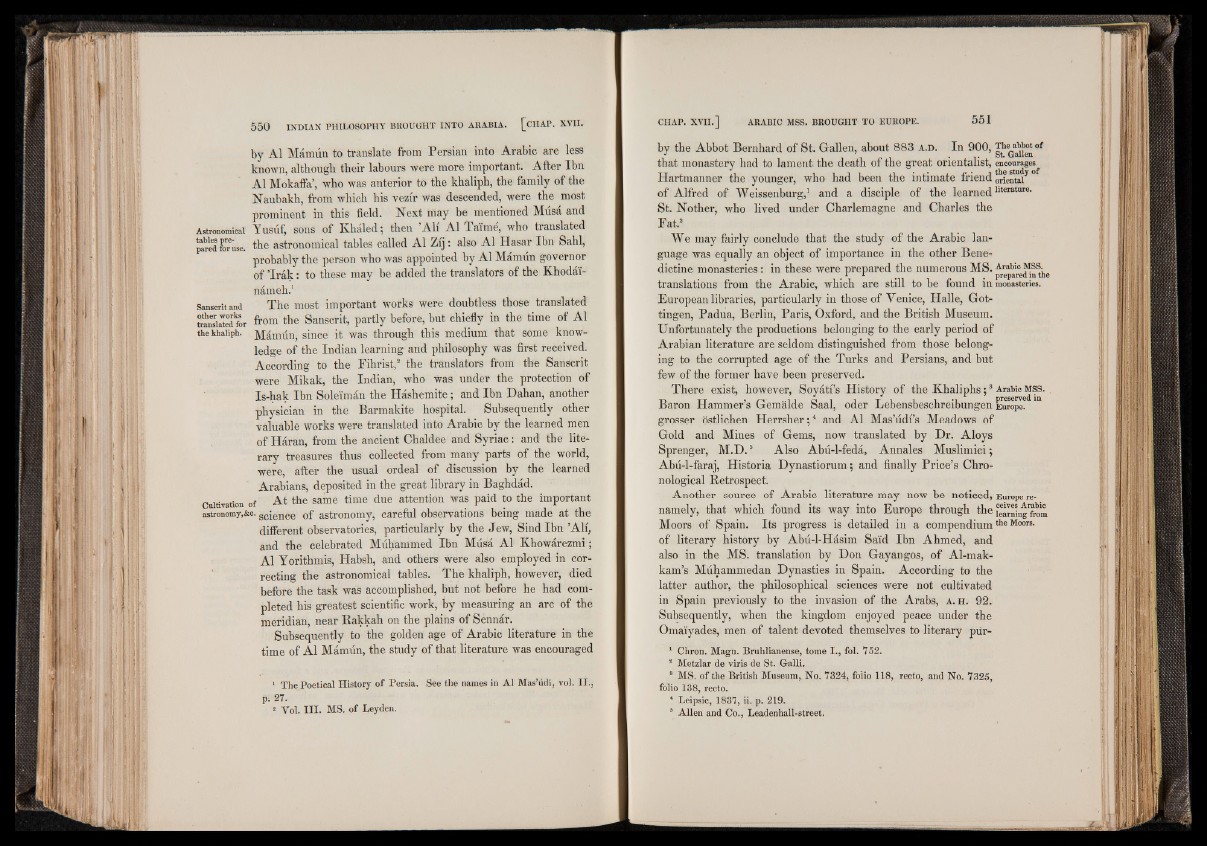
by A1 Mamun to translate from Persian into Arabic are less
known, although their labours were more important. After Ibn
A1 Mokaffa’, who was anterior to the khaliph, the family of the
Naubakh, from which his vezir was descended, were the most
prominent in this field. Next may be mentioned Musa and
Astronomical Yusuf, sons of Khaled; then ’Ali A1 Taime, who translated
^■'ed &ruse. the astronomical tables called A1 Zij: also A1 Hasar Ibn Sahl,
probably the person who was appointed by A1 Mamun governor
of ’Irak: to these may be added the translators of the Khodai-
nameh.1
Sanscrit and The most important works were doubtless those translated
tmnsiaTSfor from the Sanscrit, partly before, but chiefly in the time of A1
the khaiiph. Mamun, since it was through this medium that some knowledge
of the Indian learning and philosophy was first received.
According to the Fihrist,2 the translators from the Sanscrit
were Mikak, the Indian, who was under the protection of
Is-hak Ibn Solei'man the Hashemite; and Ibn Dahan, another
physician in the Barmakite hospital. Subsequently other
valuable works were translated into Arabic by the learned men
of Haran, from the ancient Chaldee and Syriac: and the literary
treasures thus collected from many parts of the world,
were, after the usual ordeal of discussion by the learned
Arabians, deposited in the great library in Baghdad.
Cultivation of At the same time due attention was paid to the important
astronomy,&c. s c i e n c e of astronomy, careful observations being made at the
different observatories, particularly by the Jew, Sind Ibn ’Ali,
and the celebrated Muhammed Ibn Musa A1 Khowarezmi;
A1 Yorithmis, Habsh, and others were also employed in correcting
the astronomical tables. The khaliph, however, died
before the task was accomplished, but not before he had completed
his greatest scientific work, by measuring an arc of the
meridian, near Rakkah on the plains of Sennar.
Subsequently to the golden age of Arabic literature in the
time of A1 Mamun, the study of that literature was encouraged
1 The Poetical History of Persia. See the names in A1 Mas’udi, vol. II.;
p . 27.
! Vol. I I I . MS. of Leyden.
by the Abbot Bernhard of St. Gallen, about 8 8 3 a . d . In 9 0 0 , The abbot of
, i . . . S t Gallen that monastery had to lament the death of the great orientalist, encourages
Hartmanner the younger, who had been the intimate friend oriental °f
of Alfred of Weissenburg,1 and a diseiple of the learned hterature.
St. Nother, who lived under Charlemagne and Charles the
Fat.2
We may fairly conclude that the study of the Arabic language
was equally an object of importance in the other Benedictine
monasteries: in these were prepared . 1 1 .t he numerno us M_ S. pArreapbairce dm ms s tn. e
translations from the Arabic, which are still to be found in monasteries.
European libraries, particularly in those of Venice, Halle, Gottingen,
Padua, Berlin, Paris, Oxford, and the British Museum.
Unfortunately the productions belonging to the early period of
Arabian literature are seldom distinguished from those belonging
to the corrupted age of the Turks and Persians, and but
few of the former have been preserved.
There exist, however, Soyatfs History of the Khaliphs; 3 Arabic m s s . ,
** ( preserved m Baron Hammer’s Gemälde Saal, oder Lebensbeschreibungen Europe,
grosser östlichen Herrsher;4 and AI Mas’udfis Meadows of
Gold and Mines of Gems, now translated by Dr. Aloys
Sprenger, M.D.5 Also Abü-1-fedä, Annales Muslimici;
Abu-l-faraj, Historia Dynastiorum; and finally Price’s Chronological
Retrospect.
Another source of Arabic literature may now be noticed, Europe re-
namely, that which found its way into Europe through the i’eaming'from
Moors of Spain. Its progress is detailed in a compendiumthe Moors-
of literary history by Abu-1-Häsim Said Ibn Ahmed, and
also in the MS. translation by Don Gayangos, of Al-mak-
kam’s Muhammedan Dynasties in Spain. According to the
latter author, the philosophical sciences were not cultivated
in Spain previously to the invasion of the Arabs, a . h . 9 2 .
Subsequently, when the kingdom enjoyed peace under the
Omaiyades, men of talent devoted themselves to literary pür-
1 Chron. Magn. Bruhlianense, tome I ., fol. 752.
2 Metzlar de viris de St. Galli.
8 MS. of the British Museum, No. 7324, folio 118, recto, and No. 7325,
folio 138, recto.
4 Leipsic, 1837, ii. p. 219.
5 Allen and Co., Leadenhall-street.